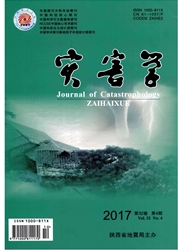

 中文摘要:
中文摘要:
基于对汶川8.0级地震同震地质灾害和震后5年来龙门山中北段地质灾害空间分布的刻厕,对震后泥石流火傅空间分布及其控制因素进行分析,获得以下认识:震后泥石流集中分布在北川-映秀断裂上盘10km范围以内,相对于同震崩塌、滑坡具有更明显的上盘效应。震后泥石流的空间分布主要受松散堆积物分布范围、地形地貌、岩性、降水等多种因素控制。其中同震崩塌、滑坡松散堆积物为震后泥石流的发生提供了重要的物质来源;地形地貌是控制震后泥石流发生的重要影响因素,为泥石流提供了势能和启动的空间条件;震后泥石流集中发生在前震旦系彭灌杂岩和古生界粉砂岩、砂岩等岩性分布区;降水是导致震后泥石流地质灾害发生的直接诱发因素。
 英文摘要:
英文摘要:
On the basis of coseismic geological disasters of and spatial distribution of geological disasters char- acterizations of the northern section in Longmen in 5 years after Wenchuan M8.0 earthquake, debris flow disaster of earthquake spatial distribution and its control factors are analyzed. Results show that debris flows after the earth- quake distributed mainly 10km within the hanging wall in Beichuan-Yingxiu fault. Compared to the same earth- quake collapse, the landslides are of more obvious hanging wall effect. The spatial distribution of landslides after the earthquake is mainly influenced by a variety of physical distribution of loose deposits, topography, lithology, precipitation and other factors. The same occurrence earthquake collapse, landslide loose deposits for post earth- quake debris flow provide important material sources. The topography is the important factor that controls the occur- rence of debris flow, and it offers potential energy and the space condition of start-up for the debris flow. After the earthquake, debris flow occurs in the pre Sinian Pengguan complex and Paleozoic siltstone, sandstone lithologic distribution area. Precipitation is the direct factor that leads to the occurrence of debris flow.
 同期刊论文项目
同期刊论文项目
 同项目期刊论文
同项目期刊论文
 Surface process and fluvial landform response to the Ms 8.0 Wenchuan Earthquake, Longmen shan, China
Surface process and fluvial landform response to the Ms 8.0 Wenchuan Earthquake, Longmen shan, China Seismotectonic Mechanisms of Lushan (Ms7.0) earthquake in the frontal propagation belt of the Longme
Seismotectonic Mechanisms of Lushan (Ms7.0) earthquake in the frontal propagation belt of the Longme Increased sediment discharge driven by heavy rainfall after Wenchuan earthquake: A case study in the
Increased sediment discharge driven by heavy rainfall after Wenchuan earthquake: A case study in the Crustal thickening or isostatic rebound of orogenic wedge deduced from tectonostratigraphic units in
Crustal thickening or isostatic rebound of orogenic wedge deduced from tectonostratigraphic units in Determination of mean recurrence interval of large earthquakes on the Garzê-Yushu Fault (Dengke Segm
Determination of mean recurrence interval of large earthquakes on the Garzê-Yushu Fault (Dengke Segm Episodic orogeny deduced from coeval sedimentary sequences in the foreland basin and its implication
Episodic orogeny deduced from coeval sedimentary sequences in the foreland basin and its implication Application of the material balance method in paleoelevation recovery: a case study of the Longmen M
Application of the material balance method in paleoelevation recovery: a case study of the Longmen M Tectonic uplift and landslides triggered by the Wenchuan earthquake and constraints on orogenic grow
Tectonic uplift and landslides triggered by the Wenchuan earthquake and constraints on orogenic grow Denudation pattern across the Longriba fault system and implications for the geomorphological evolut
Denudation pattern across the Longriba fault system and implications for the geomorphological evolut Migration of the carbonate ramp and sponge buildup driven by the orogenic wedge advance in the early
Migration of the carbonate ramp and sponge buildup driven by the orogenic wedge advance in the early Preventing and limiting exposure to geo-hazards: Some lessons from two mountain villages destroyed b
Preventing and limiting exposure to geo-hazards: Some lessons from two mountain villages destroyed b 期刊信息
期刊信息
